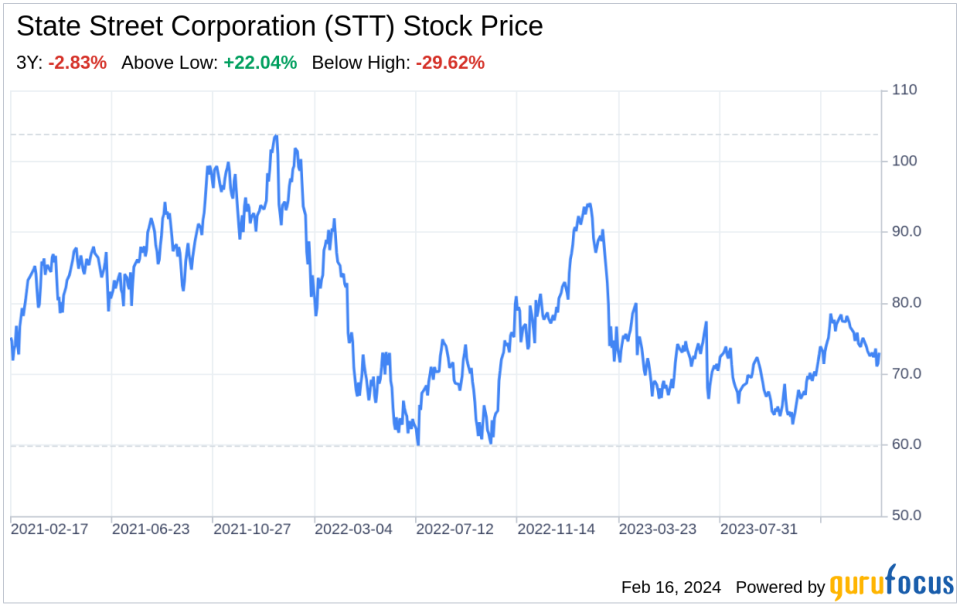Decoding State Street Corporation (STT): A Strategic SWOT Insight
Strengths: Robust global presence with $42 trillion in assets under custody and administration.
Weaknesses: Intense competition and pricing pressures challenging profitability.
Opportunities: Expansion of digital asset services and artificial intelligence integration.
Threats: Cybersecurity risks and geopolitical tensions impacting market conditions.
State Street Corporation (NYSE:STT), a titan in the realm of financial services, stands tall with an impressive $42 trillion in assets under custody and administration and $4.1 trillion in assets under management as of December 31, 2023. The company's recent SEC 10-K filing on February 15, 2024, reveals a financial fortress with consolidated total assets of $297.26 billion and consolidated total shareholders' equity of $23.80 billion. With a workforce of over 46,000, State Street operates across more than 100 geographic markets, showcasing its expansive global footprint. This SWOT analysis delves into the intricate details of State Street's financial filings to provide a comprehensive overview of its strengths, weaknesses, opportunities, and threats, guiding investors in their decision-making process.

Strengths
Global Market Leadership and Scale: State Street Corporation's formidable global presence is a testament to its market leadership, with $42 trillion in assets under custody and administration and $4.1 trillion in assets under management. This scale provides significant competitive advantages, including economies of scale, bargaining power, and a diversified client base that spans asset managers, insurance companies, and official institutions. The company's ability to service vast amounts of assets efficiently is a cornerstone of its strength, enabling it to attract and retain institutional investors worldwide.
Technological Innovation and Service Integration: State Street's commitment to innovation is evident in its development of State Street Alpha and digital asset services, which are poised to redefine investment servicing and management. These initiatives not only reflect the company's forward-thinking approach but also its ability to adapt to the evolving needs of the market. By integrating cutting-edge technology such as artificial intelligence, State Street enhances its service offerings, thereby strengthening its competitive position and creating new revenue streams.
Weaknesses
Competitive Pressures and Pricing Variability: Despite its market leadership, State Street faces intense competition that could impact its profitability. The financial services industry is characterized by fierce competition, and State Street must continuously innovate and adapt to maintain its edge. Pricing pressure is a significant concern, as clients demand more value for their investments, leading to variability in financial results and pressure on margins.
Operational and Model Risks: The complexity of State Street's services, particularly those related to digital assets and artificial intelligence, introduces operational and model risks. Dependencies on third parties and the costs associated with developing new products can strain resources and expose the company to increased risks. Additionally, the integration of acquisitions and strategic alliances presents challenges that could affect the seamless operation of the business.
Opportunities
Expansion into Digital Assets and AI Services: The burgeoning field of digital assets presents a lucrative opportunity for State Street to expand its service offerings. As institutional interest in cryptocurrencies and blockchain technology grows, State Street's initiatives in this space could position it as a leader in digital asset servicing. Moreover, the integration of artificial intelligence into its services can improve operational efficiency and client outcomes, opening new avenues for growth.
Strategic Acquisitions and Market Expansion: State Street's strategic acquisitions and joint ventures, particularly in high-growth markets like India, offer opportunities to expand its global footprint and service capabilities. By leveraging its scale and expertise, State Street can tap into new client segments and enhance its value proposition, driving long-term growth and market share gains.
Threats
Cybersecurity and Technological Risks: In an era where cyber threats are sophisticated and continually evolving, State Street's expansive digital infrastructure is vulnerable to attacks. A significant breach could lead to substantial financial losses, reputational damage, and regulatory penalties. The company must invest heavily in cybersecurity measures to protect its systems and client data, which could impact its financial performance.
Geopolitical and Market Volatility: State Street's global operations expose it to geopolitical risks, such as the ongoing war in Ukraine and other regional conflicts. These uncertainties can lead to market volatility, affecting client activity and investment performance. Additionally, regulatory changes and economic downturns in key markets could adversely impact State Street's business operations and financial results.
In conclusion, State Street Corporation (NYSE:STT) exhibits a robust set of strengths, including its global scale and technological prowess, which solidify its position as a leader in financial services. However, the company must navigate the competitive landscape, operational risks, and the ever-present threat of cyber attacks. Opportunities for growth in digital assets and market expansion are countered by the potential for geopolitical unrest and market volatility. By leveraging its strengths and addressing its weaknesses, State Street can capitalize on emerging opportunities while mitigating threats, ensuring its continued success in the dynamic financial services industry.
This article, generated by GuruFocus, is designed to provide general insights and is not tailored financial advice. Our commentary is rooted in historical data and analyst projections, utilizing an impartial methodology, and is not intended to serve as specific investment guidance. It does not formulate a recommendation to purchase or divest any stock and does not consider individual investment objectives or financial circumstances. Our objective is to deliver long-term, fundamental data-driven analysis. Be aware that our analysis might not incorporate the most recent, price-sensitive company announcements or qualitative information. GuruFocus holds no position in the stocks mentioned herein.
This article first appeared on GuruFocus.
